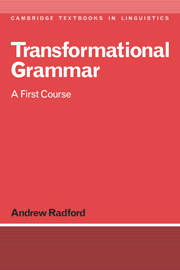9 - WH MOVEMENT
Published online by Cambridge University Press: 05 June 2012
Summary
Overview
In this chapter, we focus on one particular transformation which we have not looked at hitherto – namely the rule of WH movement. Our aim is partly methodological (to show the depth of argumentation which can be used to provide empirical support for the postulation of a single transformation), and partly theoretical (to show how detailed analysis of the operation of one rule can cause us to radically rethink our ideas about rules and structures). Since the rule of WH movement plays a key role in the syntax of so-called wh-questions, we'll begin by establishing what exactly a wh-question is. Later, we'll look at the role played by WH movement in Relative Clauses, and in other wh-constructions (Exclamatives, etc.). Finally, we'll turn to consider in some detail the question of the landing-site for moved wh-phrases, and see that this question forces us into a critical reappraisal and radical revision of our earlier assumptions about the constituent structure of Clauses.
Question types
Questions in natural languages can be classified into a number of types. One major typological division, for example, is between yes-no questions and wh-questions. Yes-no questions are so called because they permit ‘Yes’ and ‘No’ (or their counterparts in other languages) as appropriate replies – as in the following dialogue:
(1) speaker a: Are you going out tonight?
speaker b: Yes/No
Of course, speaker B does not have to reply yes or no to such a question: he might instead reply ‘Maybe’, ‘I don't think so’, ‘That's right’, ‘Why do you ask?’, ‘Mind your own business’, and so forth - but at least he has the option of answering ‘Yes’ or ‘No’.
- Type
- Chapter
- Information
- Transformational GrammarA First Course, pp. 462 - 526Publisher: Cambridge University PressPrint publication year: 1988



